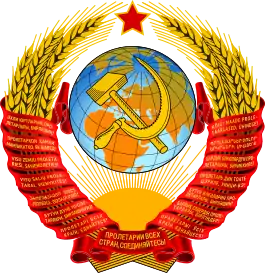Central Executive Committee of the Soviet Union
The All-Union Central Executive Committee (Russian: Всесоюзный Центральный Исполнительный Комитет, Vsesoyuznyy Tsentral'nyy Ispolnitel'nyy Komitet) was the most authoritative governing body of the USSR during the interims of the sessions of the All-Union Congress of Soviets. Established in 1922 by the First All-Union Congress of Soviets (see Treaty on the Creation of the USSR), in 1938 it was replaced by the Presidium of the Supreme Soviet of first convocation.
All-Union Central Executive Committee Всесоюзный Центральный Исполнительный Комитет | |
|---|---|
.svg.png.webp) | |
| Type | |
| Type | |
| History | |
| Established | 1922 |
| Disbanded | 1938 |
| Preceded by | None (creation of a new state)[lower-alpha 1] |
| Succeeded by | Presidium of the Supreme Soviet of the Soviet Union |
| Elections | |
| Election by the All-Union Congress of Soviets | |
| Election by the All-Union Congress of Soviets | |
| This article is part of a series on the |
| Politics of the Soviet Union |
|---|
 |
Initially the Committee consisted of four members, after 1925 there were seven. The Kazakh SSR and Kirghiz SSR were created in 1936 and did not have representatives in the Committee.
Except for Kalinin and Petrovsky, all of the Committee members were arrested and executed by shooting in 1938 during the Great Purge except for Alexander Chervyakov who committed suicide to avoid the Purge.
Description
The Central Executive Committee was created with adaptation of the Treaty on the Creation of the USSR in December of 1922. The Central Executive Committee was elected by the Congress of Soviet to govern on its behalf whenever the Congress of Soviets was not in session. The Central Executive Committee was convened by the Presidium of the Central Executive Committee, which was elected by the Central Executive Committee to govern on its behalf whenever it was not in session.
By the 1924 Soviet Constitution, the Central Executive Committee comprised two chambers: the Soviet of the Union (delegates elected broadly) and the Soviet of Nationalities (delegates elected regionally). At the constituent republic level there operated a Central Executive Committee in each of the federal republics:
- the All-Russian Central Executive Committee in the RSFSR
- the All-Byelorussian Central Executive Committee in the Byelorussian SSR
- the All-Ukrainian Central Executive Committee in the Ukrainian SSR
- the All-Caucasian Central Executive Committee of the Transacaucasian SFSR
Leadership
Presidium chairmen
The Presidium of the Central Executive Committee consisted of 21 members and included the Presidia of the Soviet of the Union and the Soviet of Nationalities. A representative of each constituent republic (initially four) was elected one of the directors of the presidium.
- Russian Soviet Federative Socialist Republic: Mikhail Kalinin (December 30, 1922 - January 12, 1938)
- Ukrainian Soviet Socialist Republic: Grigory Petrovsky (December 30, 1922 - January 12, 1938)
- Byelorussian Soviet Socialist Republic: Alexander Chervyakov (December 30, 1922 - June 16, 1937)
- Transcaucasian Socialist Federative Soviet Republic:
- Nariman Narimanov (December 30, 1922 - March 19, 1925)
- Gazanfar Musabekov (May 21, 1925 - June 1937)
As more entities (usually previously Autonomous Soviet Socialist Republics) were promoted to the status of constituent republics of the USSR, they received representation among the directors of the Presidium:
- Uzbek Soviet Socialist Republic (from 1924): Fayzulla Khodzhayev (May 21, 1925 - June 17, 1937)
- Turkmen Soviet Socialist Republic (from 1925): Nedirbay Aytakov (May 21, 1925 - 21 July 1937)
- Tajik Soviet Socialist Republic (from 1929):
- Nusratullo Maksum (March 18, 1931 - January 4, 1934)
- Abdullo Rakhimbayev (January 4, 1934 - September 1937)
Presidium secretaries
- 1922 – 1935 Avel Yenukidze
- 1935 – 1937 Ivan Akulov
- 1937 – 1938 Aleksandr Gorkin
Soviet of Nationalities chairmen
Powers
The 1924 Soviet Constitution defined the powers of the CEC as:
- Calling of the Congresses of Soviets
- Election of the Council of the People's Commissars (Sovnarkom)
- Adoption of decrees and legislative acts
- Work concerning legislation and management.
Notes
- per statement of the First All-Union Congress of Soviets